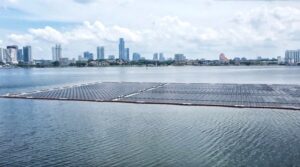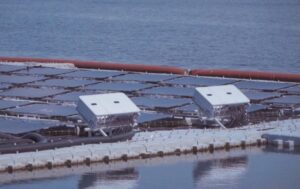Offshore Floating-PV Powers Singapore’s Journey Toward Carbon Neutrality
The market for solar energy is heating up worldwide in a concerted, global effort to fight against climate change. Singapore is now home to one of the world’s largest offshore floating Photovoltaic (PV) farms, a 5 MW-peak project that’s been deployed in the Straits of Johor.
Developed by Sunseap Group, a solar energy solutions provider in Singapore, the five-hectare sea-based solar plant is equivalent in size to five soccer fields. With 13,312 solar panels, 40 inverters, and more than 30,000 floats, it’s estimated to produce up to 6,022,500 kWh of energy per year, supplying enough power for 1250 four-room public housing flats on the island and offsetting an estimated 4258 tons of carbon dioxide.

The nation needs to significantly reduce its reliance on fossil fuels. Finding alternative methods to generate electricity is essential, as natural gas is responsible for 97% of electricity generation in Singapore. The Singapore Green Plan 2030 initiative to advance Singapore’s national agenda on sustainable development aims to halve its peak greenhouse gas emissions by 2050.
Singapore lacks access to natural and renewable energy sources such as wind and hydroelectric power. However, located almost on the equator, Singapore draws a high average annual solar irradiance. Simply put, it gets a lot of sun. As such, one of the key targets under the Green Plan 2030 is to quadruple solar energy deployment to 1.5 GW-peak by 2025, with further plans to reach 2 GW-peak by 2030.
Singapore’s spatial constraints led Sunseap to look offshore, to the open seas, as a viable alternative for renewable energy, ultimately deploying the PV system in coastal waters. In doing so, Sunseap also achieved another milestone: constructing an undersea cable system connecting the floating platform to the mainland, creating a 22 KV electrical distribution network.
Unlike inland water bodies, the open sea is subject to a range of conditions and is prone to change, from fluctuations in temperature and rough swells to the corrosive nature of saltwater. Such unfavorable conditions, combined with the biofouling commonly found in warm tropical waters — where microorganisms, plants, algae, and small animals accumulate on surfaces — can potentially accelerate the degradation of PV system components, such as inverters.
By tapping into its expertise in integrating Artificial Intelligence (AI) and the cloud, Huawei introduces the latest Information and Communications Technology (ICT) into PV equipment to optimize power generation. Sunseap selected Huawei to supply its field-proven smart string inverters — Huawei SUN2000-90KTL-H2 — to make the floating solar farm more efficient, safer, and more reliable.
The inverters have undergone a series of tests for salt corrosion and heat dissipation, demonstrating their resilience to harsh environments and temperatures ranging from -55°C to 80°C. By deploying Huawei inverters, Sunseap has been able to streamline the Operations and Maintenance (O&M) process of the floating platform, as well as prevent rust and general material wear and tear.

Shawn Tan, Vice President of Engineering at Sunseap, said: “The portability of Huawei’s string inverters was a key feature as it allowed us to install the inverters directly onto the floating platform, next to the PV panels. This eliminated the need for a Direct Current (DC) cable hose and DC combiner boxes, reducing costs and deployment times. Owing to the unique [modular] design of the inverters, heat is dissipated more efficiently, increasing the overall reliability of the entire solar PV system.”
By implementing Huawei’s smart string inverters, Sunseap has also streamlined the O&M process and its engineers are now able to conveniently conduct daily routine checks remotely. Plant issues can be diagnosed remotely as well as troubleshooting without having to be physically onsite.
Frank Phuan, Co-founder and Chief Executive Officer (CEO) of Sunseap, remarked: “The Green Plan from the Singapore government is a strong commitment against climate change and the offshore floating 5 MW-peak plant that we have here is just a small step forward on the path to carbon neutrality. I hope, in the future, Sunseap and Huawei will continue to contribute to the clean energy landscape here in Singapore.”
Picture Source: Huawei